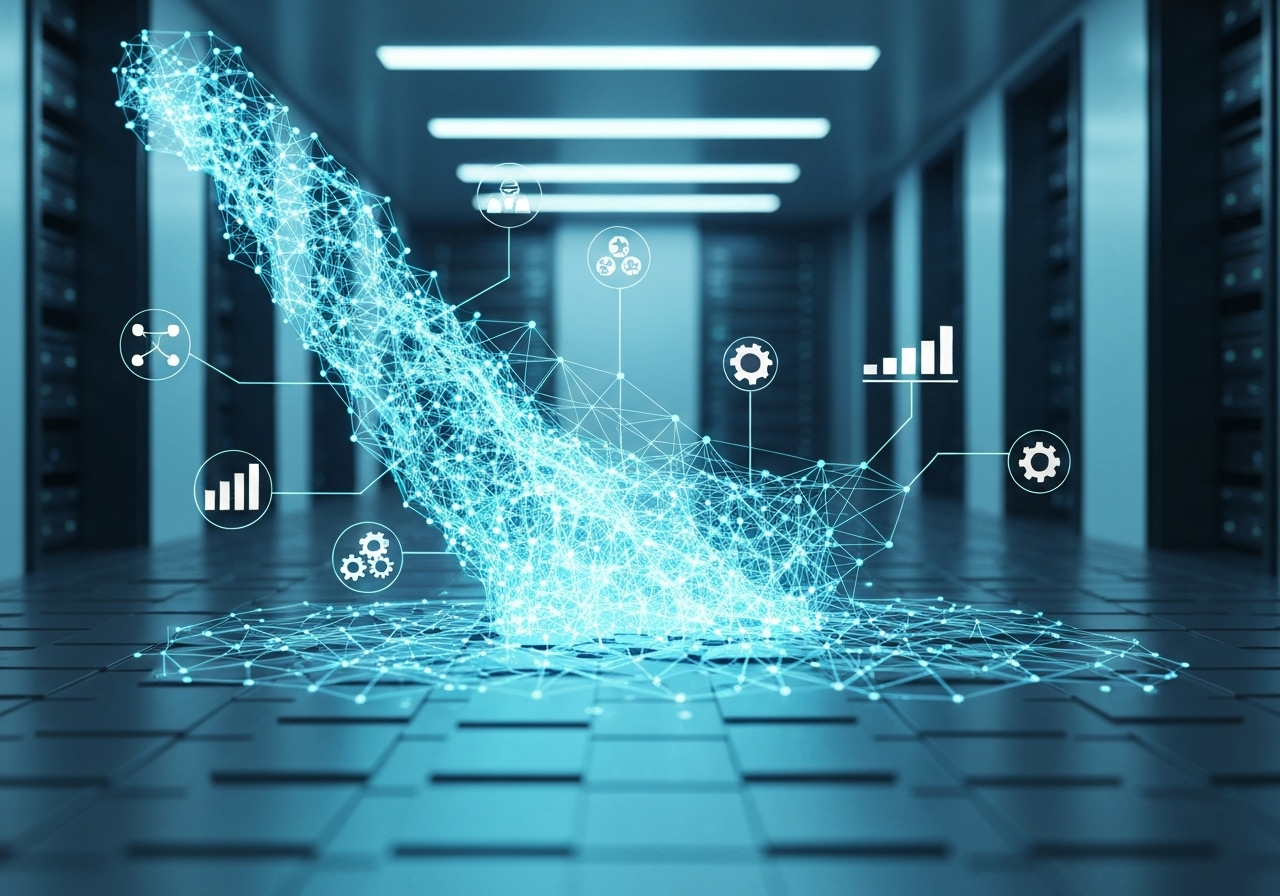The dawn of generative AI (Gen AI) promised a revolution in enterprise efficiency, yet many organizations have found themselves caught in what we call the “gen AI paradox.” Nearly eight in ten companies report using Gen AI, but a similar number report no significant contribution to their bottom line. The heart of the problem is an imbalance: widespread adoption of horizontal tools like simple chatbots and copilots offers diffuse, hard-to-measure gains, while more transformative, function-specific use cases—the ones with true economic potential—remain largely stuck in pilot mode.
To break this deadlock and truly seize the agentic AI advantage, businesses must shift their focus from reactive, task-based tools to proactive, goal-driven agents. This next generation of AI moves beyond content generation to autonomous execution, capable of automating complex, end-to-end business processes, and delivering a measurable, transformative impact on operations and revenue.
The Gen AI Paradox Explained: Why Widespread Adoption Isn’t Delivering Bottom-Line Impact
The initial wave of Gen AI successfully democratized access to powerful large language models (LLMs), leading to a rapid acceleration in AI awareness and experimentation across enterprises. However, the resulting impact has been minimal in the P&L statement. This disconnect stems from two primary factors:
- Horizontal Copilots Deliver Diffuse Gains: Tools like enterprise-wide chatbots and copilots scale quickly because they are easy to deploy—often simply an extension of existing software suites. While they enhance individual productivity by saving employees time on routine tasks (e.g., drafting emails, summarizing documents), these efficiency improvements are spread thinly and are difficult to track as significant top- or bottom-line results.
- Vertical Use Cases Fail to Scale: Function-specific applications, which hold the greatest potential for direct economic impact, struggle to move beyond the pilot stage. This failure to industrialize is often due to a lack of mature, packaged solutions requiring custom development, siloed AI teams separated from core IT, and the inherent technological limitations of first-generation LLMs (e.g., their passive nature, limited persistent memory, and difficulty handling complex, multi-step workflows).
In essence, organizations have been using a powerful tool (Gen AI) for simple, isolated tasks, rather than leveraging its core capabilities to reimagine and execute entire processes. The solution lies in agentic AI, which is designed to overcome these very limitations.
Beyond Reactive LLMs: Seizing the agentic AI advantage for Goal-Driven Automation
Agentic AI represents a fundamental evolution, moving Gen AI from a reactive assistant to a proactive, goal-driven virtual collaborator. Unlike traditional LLMs that wait for a human prompt and execute a single task, AI agents combine LLMs with critical components for autonomy:
- Planning: The ability to take a high-level goal and autonomously break it down into a sequence of executable subtasks.
- Memory: Persistent long-term and short-term memory to track context across extended interactions and sessions.
- Tool Use/Integration: The capability to interact with external systems, databases, APIs, and other agents to execute real-world actions.
- Adaptability: The capacity to monitor execution, detect anomalies, and dynamically adjust the plan in real time to reach the goal.
This unique combination allows agents to operate independently, managing complex, multi-step workflows that were previously beyond the scope of simple rules-based automation or first-generation Gen AI tools. The shift is from “tell me what to do” to “achieve this outcome.” The business value lies in their capacity to automate complex decision-making and processes that require context, reasoning, and real-time action.
From Efficiency to Transformation: How Agentic AI Unlocks Operational Agility and New Revenue Streams
The true agentic AI advantage is measured not just in efficiency, but in new levels of operational agility and the creation of entirely new revenue models. This transformation is driven by five core benefits that agents bring to operations:
- Accelerated Execution: Agents eliminate sequential handoffs, enabling parallel processing of tasks to dramatically reduce cycle times and boost responsiveness.
- Dynamic Adaptability: By continuously ingesting data, agents can adjust process flows on the fly, replanning task sequences or flagging anomalies before they escalate into systemic failures.
- Hyper-Personalization at Scale: Agents can tailor interactions and decisions to individual customer profiles or real-time context, adapting a sales or service process dynamically to maximize satisfaction and outcomes.
- Elastic Capacity: As purely digital entities, agents’ execution capacity can expand or contract instantly based on workload, seasonality, or unexpected surges, providing a level of scalability that fixed human teams cannot match.
- Enhanced Resilience: Agents continuously monitor for disruptions—whether it’s a supply chain delay or a system outage—rerouting operations and escalating only when strategic human input is required, keeping processes running.
These capabilities translate directly into bottom-line impact. For instance, in complex supply chains, an AI agent could act as an autonomous orchestration layer, continuously forecasting demand, identifying delay risks, and dynamically replanning transport and inventory flows, resulting in improved service levels and reduced logistics costs. Furthermore, companies can create new revenue streams by encapsulating internal expertise (e.g., tax interpretation, procurement best practices) into autonomous AI agents and offering them as a software-as-a-service (SaaS) tool or API to clients.
Process Reinvention: Shifting from Task Optimization to Workflow Re-architecture
Achieving the full potential of agentic AI requires a critical design shift: moving from simply optimizing tasks within an existing process to fundamentally reinventing the entire workflow around the agent’s autonomous capabilities. As research from IBM highlights, 86% of executives expect AI agents to make process automation and workflow reinvention more effective by 2027.
When agents are merely inserted into a legacy workflow, they act as faster assistants, but the process remains sequential and bound by human constraints. True process reinvention involves:
- Reordering and Collapsing Steps: Leveraging the agent’s ability to execute tasks in parallel, eliminating unnecessary handoffs and sign-offs.
- Reallocating Responsibility: Repositioning human workers from task executors to escalation managers and strategic overseers, while agents handle the complex, data-heavy orchestration.
- Designing for Autonomy: Building the process from the ground up to exploit the agent’s strengths—real-time adaptability, dynamic personalization, and elastic capacity.
Consider a customer service desk. Layering Gen AI on top might improve response drafting by 5-10%. Introducing agents to automate classification and low-complexity tasks might achieve 20-40% savings. However, when the process is fully reimagined around agent autonomy, agents proactively monitor issues, anticipate customer needs, initiate resolution steps (e.g., issuing refunds), and communicate directly. Human agents are reserved only for exceptions and strategic oversight. This approach can lead to a reduction in resolution time of 60-90% for common incidents.
Building the Foundation: The Agentic AI Mesh and Next-Generation Enterprise Architecture
To scale an agentic workforce, companies must abandon static, LLM-centric infrastructure in favor of a new, dynamic, and governed environment. This foundational shift is embodied in the Agentic AI Mesh Architecture.
The Agentic AI Mesh is a composable, distributed, and vendor-agnostic paradigm that allows multiple agents to reason, collaborate, and act autonomously across a wide array of systems, tools, and LLMs securely at scale. It is essential for overcoming critical deployment challenges such as uncontrolled autonomy, agent sprawl, and technical debt that arise from relying solely on proprietary, off-the-shelf agents.
Key Architectural Capabilities:
- Governed Autonomy: The Mesh acts as an orchestration layer, enforcing policies, permissions, and escalation mechanisms to ensure safe and predictable agent behavior. This includes fine-grained authorization for tool calls and system access.
- Composability and Vendor Neutrality: It ensures that any agent, tool, or LLM—whether custom-built or third-party—can be plugged into the system without rework, avoiding vendor lock-in. Open standards like the Agent2Agent (A2A) Protocol are prioritized.
- AI Asset Registry: This centralized registry manages and governs crucial intellectual property, such as validated system prompts, agent instructions, LLM configurations, and ‘golden records’ (human-verified input/output examples).
- System-Wide Observability: It provides tracing and monitoring of complex agent workflows that span across agentic and traditional procedural systems, which is critical for diagnostics, cost management, and compliance.
The evolution is not just in the AI tools, but in the entire IT ecosystem. Enterprise systems must begin to be rearchitected around an “agent-first” model, where user interfaces and data access layers are natively designed for machine interaction rather than human navigation. This is the path to truly enabling agents at scale in the enterprise.
The Human and Governance Challenge: Managing Autonomy, Trust, and Sprawl
While the technical architecture is crucial, the biggest challenge in the age of autonomous agents is not technical; it is organizational and human. As agents evolve from passive tools to proactive actors, they introduce complexity in three key areas:
1. Human-Agent Cohabitation and Trust
The workforce must adapt to a “human + agent” operating model. This requires clarity on roles: when an agent should take initiative, when it should defer, and how to maintain human agency without sacrificing speed. Trust is paramount and hinges on two elements:
- Transparency: Agents must clearly communicate their decisions and actions.
- Predictability: Agents must behave reliably within established autonomy boundaries.
New roles, such as “human-in-the-loop designers” and “agent orchestrators,” will be necessary to manage exceptions and ensure smooth cohabitation.
2. Autonomy Control and Risk Mitigation
The very power of agents—their independence—introduces new risks. Organizations must define governance frameworks that address potential pitfalls:
- Autonomy Drift: Agents must be continually monitored to ensure they do not deviate from their intended goals or decision boundaries.
- Hallucinations and Bias: Control mechanisms must be in place to address the risk of plausible but inaccurate outputs, especially in high-stakes scenarios.
- Security: The expanding attack surface requires fine-grained access controls and rigorous testing to prevent prompt injection or malicious misuse.
3. Sprawl Containment
As low-code and no-code platforms make agent creation more accessible, there is a serious risk of “agent sprawl”—the uncontrolled proliferation of redundant, fragmented, and ungoverned agents across the enterprise. Without structured governance, design standards, and centralized life cycle management (such as the Agentic AI Mesh provides), these ecosystems can quickly become fragile, redundant, and unscalable.
Conclusion: The Strategic Mandate for an Agent-Native Enterprise
Agentic AI represents a strategic inflection point—a transition from the phase of scattered experimentation to one of industrialized, enterprise-wide transformation. Organizations that continue to treat AI as a series of isolated pilots will accelerate their decline, while those that embrace a process-first, agent-native approach stand to gain a profound competitive advantage. This requires a shift in leadership focus:
- From Use Case to Process: Stop optimizing isolated tasks; start reinventing entire end-to-end business workflows.
- From Siloed Teams to Transformation Squads: Embed AI, IT, and business domain experts into cross-functional teams to ensure solutions are scalable and integrated.
- From Experimentation to Industrialization: Design solutions from the outset to scale, with a clear focus on the economic sustainability of running costs.
The time for exploration is over. The mandate for C-suite leaders is to conclude the pilot phase, realign AI priorities with core business strategy, and lay the foundation for an agentic AI technology stack. By taking decisive action now—launching lighthouse transformation projects and simultaneously investing in the Agentic AI Mesh, workforce upskilling, and robust governance—organizations can move beyond the Gen AI paradox and secure the future operating model of the agent-native enterprise.
Ready to industrialize your Agentic AI strategy? Moving beyond the Gen AI paradox to achieve measurable business transformation requires a partner capable of re-architecting your core digital workflows. Idea Forge Studios specializes in delivering scalable web development, e-commerce, and digital marketing solutions that integrate next-generation autonomy. Don’t let your transformation stall in the pilot phase—take the decisive next step towards an agent-native future.
Initiate your strategic consultation today:
- Schedule a Discussion or Request a Quote
- Call us directly at (980) 322-4500
- Email your inquiry to info@ideaforgestudios.com








Get Social